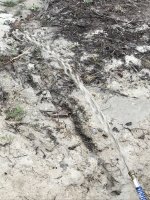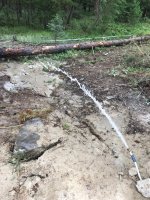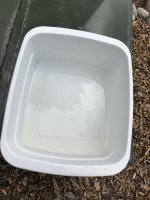Hi there
I would first like to say thank you for taking the time out of your day to read and hopefully help me out, I have been reading ALOT of posts about New wells and dirty water, & to run and KEEP running the water for weeks, etc.. etc... to get the well developed/ clean water, But my problem seems completely bass-ackwards.
My problem is that the water is coming clean but only when the yard hydrants (1 or 3 all running it dosen't matter) are running full tilt flow. Initially when the hydrant is turned on, there is a bit of silt (minimal which settles to the bottom of a bucket after some time) & after 5-10 minutes running fully open (currently), it comes clean with no sediments. Great.. until.. you choke the flow down to a half or 3/4 of the speed, which then the water becomes silty and dirty.
*should be noticed that expected GPM flow rates from charts at given depths/ feet are accurate.
I have been flowing full tilt for a 1-3 hours a day for the past 7-9 days
until I started taking notes the past 3-4 days
Day A
full flow- 5-45 minutes (getting faster everyday)
Day B
3/4 flow rate: it doesn't clear up/ mud for 2 hours. Open it up full throttle, cleans up again with in 45 min.
Day C
Full throttle- little silty to start, 15 minutes a little muddy, 2 hours clear
*300 ft total depth, pump currently set at 278 ft
Static water 135'
6 inch metal casing (air drilled and welded)
Well Information:
- 300ft TD @ recovery rate of 60(ish) gpm, bucket measurement taken over flowing well for 3 hrs periodically
0-60 yellow sand with gravel
60-180 yellow clay with gravel (hit a little water at 125)
180-240 grey clay
240-260- grey clay with gravel
260- 280 fine gravel/ sand (hit water at 265) Flowed at 17 gpm (decided to go one more stand)
280-300 (TD) gravel about (3/4 crush sized).
Equipment Ran:
Webtrol 35 gpm pump end (WT3550L)
Franklin Electric 5 hp motor, 3 phase, 60 hz, 230V
Franklin Electric Sub Drive 300, Nema 4
3 check valves
1.5" drop pipe
1 1/4 water lines to 3 hydrants.
30 g pressure tank set at stock (50psi)
Does anyone have any suggestions, Keep flowing, am I overflowing the well, flow on 1/2 flow longer, flow full tilt????etc.. Maybe this is normal but I haven't came across a thread like this yet.. I am sorry if theres one out there that I missed as I am new to the forum.
Thank you so much for your time and I look forward to hearing from you!
I would first like to say thank you for taking the time out of your day to read and hopefully help me out, I have been reading ALOT of posts about New wells and dirty water, & to run and KEEP running the water for weeks, etc.. etc... to get the well developed/ clean water, But my problem seems completely bass-ackwards.
My problem is that the water is coming clean but only when the yard hydrants (1 or 3 all running it dosen't matter) are running full tilt flow. Initially when the hydrant is turned on, there is a bit of silt (minimal which settles to the bottom of a bucket after some time) & after 5-10 minutes running fully open (currently), it comes clean with no sediments. Great.. until.. you choke the flow down to a half or 3/4 of the speed, which then the water becomes silty and dirty.
*should be noticed that expected GPM flow rates from charts at given depths/ feet are accurate.
I have been flowing full tilt for a 1-3 hours a day for the past 7-9 days
until I started taking notes the past 3-4 days
Day A
full flow- 5-45 minutes (getting faster everyday)
Day B
3/4 flow rate: it doesn't clear up/ mud for 2 hours. Open it up full throttle, cleans up again with in 45 min.
Day C
Full throttle- little silty to start, 15 minutes a little muddy, 2 hours clear
*300 ft total depth, pump currently set at 278 ft
Static water 135'
6 inch metal casing (air drilled and welded)
Well Information:
- 300ft TD @ recovery rate of 60(ish) gpm, bucket measurement taken over flowing well for 3 hrs periodically
0-60 yellow sand with gravel
60-180 yellow clay with gravel (hit a little water at 125)
180-240 grey clay
240-260- grey clay with gravel
260- 280 fine gravel/ sand (hit water at 265) Flowed at 17 gpm (decided to go one more stand)
280-300 (TD) gravel about (3/4 crush sized).
Equipment Ran:
Webtrol 35 gpm pump end (WT3550L)
Franklin Electric 5 hp motor, 3 phase, 60 hz, 230V
Franklin Electric Sub Drive 300, Nema 4
3 check valves
1.5" drop pipe
1 1/4 water lines to 3 hydrants.
30 g pressure tank set at stock (50psi)
Does anyone have any suggestions, Keep flowing, am I overflowing the well, flow on 1/2 flow longer, flow full tilt????etc.. Maybe this is normal but I haven't came across a thread like this yet.. I am sorry if theres one out there that I missed as I am new to the forum.
Thank you so much for your time and I look forward to hearing from you!



